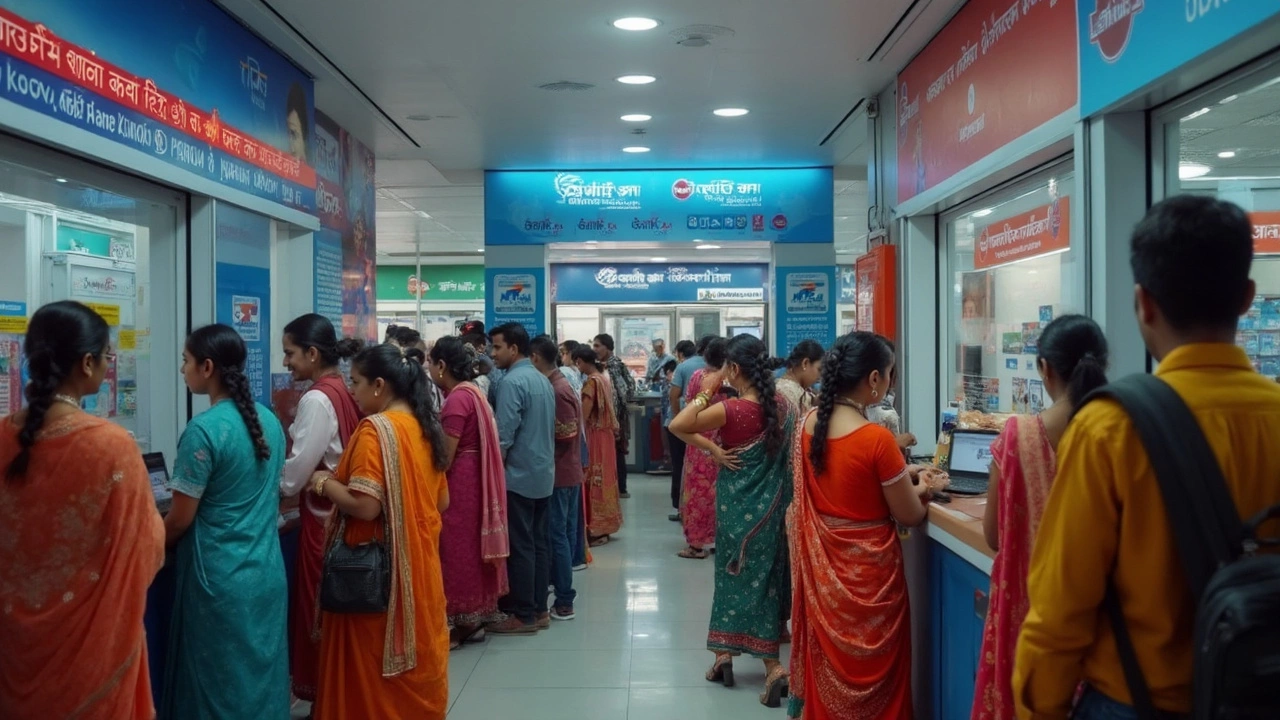
Standing in line at a branch just to update your passbook feels like something from another era, doesn’t it? Digital banking isn’t just a tech buzz in India anymore—it's a game-changer for how people handle their money. More than half of everyday banking, from transferring cash to paying the electricity bill, happens online, all through your phone or computer.
If you’ve ever wondered whether it’s worth ditching the old-school bank visits for a banking app, you’re not alone. UPI payments and online transfers are now part of daily life for millions—even my son Vihaan pays his school fees with a tap. Still, questions pop up: Is it safe? Can you get real help if you need it? Will you miss out on anything by going all-digital?
This guide clears the air. Whether you’re totally new, or just nervous about going all-in with online banking, I’ll walk you through what actually changes and what you can expect. No confusing terms. Just straight talk and practical tips, so you can decide if it’s finally time to switch.
- How Online Banking Works in India
- Key Features and Benefits
- Comparing Offline and Online Banking
- Safety: What You Need to Know
- Tips for Stress-Free Digital Banking
How Online Banking Works in India
Online banking in India covers way more than checking your balance on your phone. It gives you access to practically all the stuff you’d normally do at a branch—only faster and without leaving your sofa. Every major bank, from SBI to HDFC and ICICI, now lets you handle money through apps and websites. This is where online banking really scores big in convenience.
To get started, you need two things: an active bank account and a working internet connection. Most apps do a quick registration. A trip to the branch is rarely needed except for opening your first account or KYC updates. Once you’re set up, your user ID and password (or fingerprint/Face ID if your phone has it) get you in. Bill payments, fund transfers, and even booking train tickets or shopping on Amazon—most of it can happen from the same app.
- UPI (Unified Payments Interface): The biggest player. UPI lets you send money, split bills, pay shops—all just with a mobile number or even a QR code.
- IMPS/NEFT/RTGS: Online fund transfers between banks, different timings and fees, but faster than doing it at the bank itself.
- Mobile Wallets: Paytm, PhonePe, Google Pay—these connect to your account and make small purchases a breeze.
- Account Services: Download statements, order cheque books, block lost cards, request loans—no paperwork, no waiting.
Here’s a quick table to show just how huge online banking has become in India:
| Year | UPI Transactions (Billion) | Value (INR Trillion) |
|---|---|---|
| 2021 | 38 | 71.54 |
| 2022 | 74 | 126.95 |
| 2023 | 117 | 182.27 |
Source: NPCI official stats as of May 2024
Most apps even let you set spending limits, freeze cards, or set up instant alerts for every transaction. That means you’re always in the know about what’s happening with your money, no matter where you are. Banks also throw in customer support through chat or phone right inside the app. If you ever get stuck, help is one tap away.
Key Features and Benefits
There’s a reason over 160 crore UPI transactions happen in India every week—online banking is loaded with advantages. The main thing? You can control almost everything in your account right from your phone, any time of day. No more running to the bank before it closes or stressing about holiday schedules.
- online banking means you can check balances, transfer money, pay bills, or even open a fixed deposit at 2am—no questions asked.
- Transferring money has never been faster. IMPS and UPI let you send funds in real time, even on Sundays. The days of worrying over cheque clearing times are over.
- Know someone who always forgets due dates? Most bank apps let you set up automatic payments for everything from electricity to credit cards. Set it once and stop paying late fees.
- KYC updates and minor tasks like requesting a cheque book or blocking your ATM card are just a few taps away now. No paperwork or waiting involved.
- Many banks throw in extras—think investment tracking, instant insurance buying, and quick personal loans right inside the app. No more chasing random agents for small things.
The best part is you get constant access, security features like app lock and fingerprint login, and instant alerts every time money moves in or out.
| Feature | Offline Banking | Online Banking |
|---|---|---|
| Money Transfer | 1-2 days (cheques/RTGS) | Instant (UPI, IMPS) |
| Account Access | Bank hours only | 24/7 from home |
| Bill Payments | Manual with slips | Automated, scheduled |
| Customer Support | Face-to-face, limited hours | Chatbots, 24/7 helplines |
| Savings & Investments | Branch visit needed | App-based, on demand |
For most families, life honestly gets simpler once you start using online banking. Whether you’re making a quick UPI payment at a vegetable shop or teaching your teenager about saving, having everything in one place—and always in your pocket—just makes sense.

Comparing Offline and Online Banking
The real question is, what actually changes when you leave the branch behind and switch to online banking? Let’s break it down practically, so you know what’s truly better and what you might miss.
| Feature | Offline Banking | Online Banking |
|---|---|---|
| Access Hours | 10am-4pm (typical) | 24/7, anytime & anywhere |
| Basic Transactions | Standing in queues, paperwork | Done in seconds via app/website |
| Bill Payments | Fill slips, wait at counter | Instant online – UPI, bank app, website |
| Customer Help | Face-to-face, but slow during peak hours | Chat support, calls, email (some banks 24/7) |
| Large Transactions (e.g. >Rs 2 lakh) | Visit branch, sign forms | Mostly online, but some limits apply |
| Account Opening | Fill forms, visit branch, submit copies | Can be fully digital with e-KYC in minutes |
Here’s what stands out:
- Convenience: Most people love not having to travel or wait. You can literally transfer money or pay a bill on a Sunday night from your sofa.
- Speed: With UPI, NEFT, or IMPS, it takes less than a minute for most transactions. No more filling out slips or waiting for your number.
- Record-keeping: Your transaction history, statements, and loan info are always available online. No more passbook printing drama.
- Costs: Some banks give lower charges for online services. For example, NEFT via net banking is often free, while the branch might charge ₹2-₹5 per transaction.
But let’s be clear — offline banking isn’t useless. Need to deposit a cheque, withdraw a huge cash amount, or solve a thorny issue face-to-face? Branches still matter. Sometimes, rural branches are the backbone for people who aren’t comfortable using smartphones yet. There’s also a learning curve if you’re new to apps.
According to RBI, by early 2025, more than 60% of banking transactions in India were happening online or via mobile. Yet, about 15% of the population still relied on branches for their main banking needs, especially for senior citizens or in smaller towns.
In short? Switching to online banking makes life a lot easier for everyday work—but don’t count out your neighbourhood branch just yet, especially for big stuff or special cases.
Safety: What You Need to Know
Worried about the safety of your money when you use online banking? You’re not paranoid—cyber frauds, phishing, and hacking attempts are real. But banks in India throw a pretty solid safety net around your cash. They use multi-layered systems like OTPs (One Time Passwords), biometric logins, PINs, and app passwords. It’s not old-school locked vaults, but these digital locks are tough for fraudsters to crack if you stay alert.
RBI, the big boss of banking in India, lays down strict security rules for every bank. In fact, as per RBI’s own annual report for 2023, Indian banks reported less than 0.005% of total digital transactions as fraud. That’s less than 5 in every 100,000 transactions. Not bad, right?
| Safety Feature | How It Protects You |
|---|---|
| OTP (One Time Password) | Confirms every transaction with your phone |
| Biometric Login | Uses fingerprint or face scan for access |
| 2-Factor Authentication | Adds a second layer beyond username and password |
| Transaction Alerts | Sends instant SMS/email for each activity |
| Session Timeout | Auto-logs out after inactivity |
Still, no app is totally bulletproof. Social engineering tricks—where scammers pretend to be bank staff—are common. Here’s a golden piece of advice I always follow (and repeat to my son Vihaan): Never share your PIN, password, or OTP with anyone, even if they claim to be from the bank. Banks will never ask these details on call or over message.
"The future of banking is digital, but its safety depends largely on how users protect their own data" — Rajesh Pant, National Cyber Security Coordinator of India
If you spot a transaction you didn’t make, report it to your bank within three days. RBI rules say you get full money back if you raise the alarm fast. Most mobile banking frauds happen when people ignore basic safety. So here’s a short checklist:
- Download your bank app only from the official Play Store or App Store.
- Set a strong, unique password and change it every six months.
- Never click suspicious links or download apps from WhatsApp forwards.
- Update your app and phone regularly for the latest security patches.
- Use your own device and private internet instead of public Wi-Fi for banking work.
When you keep these habits, online banking is honestly safer than carrying a wallet stuffed with cash or passbook. The tech is solid—it’s our everyday habits that make the biggest difference.

Tips for Stress-Free Digital Banking
Shifting to online banking can feel intimidating at first, but a few smart habits make the whole thing much easier. The knack is mostly about keeping things simple and secure.
First and foremost: only use your bank's official app or website. There are tons of fake lookalike apps out there. Always check that little padlock in your browser address bar, and don’t click links from random emails or messages, no matter how official they look.
Second, keep your passwords strong and unique. Mix letters, symbols, and numbers, and don’t use birthdays or easy guesses. Refreshing your password every few months is way better than dealing with a hacked account. And for those like me who forget passwords, a password manager is a lifesaver.
Enable two-factor authentication (2FA). It’s one extra step, but it blocks most fraud attempts, especially since UPI transactions in India are a favorite target for scams. If your bank offers biometric logins or OTPs, use them—they don’t take much time and really help with security.
| Mistake | What to Do Instead |
|---|---|
| Sharing OTPs or PINs | Never share these, even if the caller claims to be from your bank |
| Using public Wi-Fi for transactions | Stick to your mobile data or trusted home Wi-Fi |
| Ignoring app updates | Update banking apps regularly for new security features |
| Not monitoring account | Set up transaction alerts and review statements often |
Don’t forget: if something feels odd, stop immediately and call your bank’s official helpline. As the Reserve Bank of India advises:
“Neither RBI nor banks send customers links for online banking or ask for confidential details. Never share your banking credentials with anyone, even if the request seems urgent.”
And when setting up your online banking, make sure to turn on transaction alerts on SMS and email. Indian banks offer this by default now, and it’s one of the best ways to catch any weird activity fast.
- Check your account at least once a week—even if it’s just a glance
- Set transaction limits you’re comfortable with for UPI and IMPS
- If you lose your phone, lock access to your account ASAP
Digital banking shouldn’t feel like a chore. It’s meant to make your life easier, not more stressful. If you build these habits, you’ll dodge nearly all common headaches. Trust me, I’ve seen too many avoidable slip-ups just because people skipped these simple steps.





Write a comment